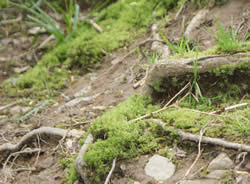 There was a bit of a duck population explosion a few years ago (from three to 10 or so ducks) at Chris Dixon's. The increase in duck feet meant that the soil on their regular route down to the pool had been eroded and the tree roots steadily exposed. On top of this, the change in weather patterns over the recent years has increased the occurrence of sudden downpours of rain. The huge quantities of water hurtle down the stream (raising the level of the water) and causes further damage to the banks.
There was a bit of a duck population explosion a few years ago (from three to 10 or so ducks) at Chris Dixon's. The increase in duck feet meant that the soil on their regular route down to the pool had been eroded and the tree roots steadily exposed. On top of this, the change in weather patterns over the recent years has increased the occurrence of sudden downpours of rain. The huge quantities of water hurtle down the stream (raising the level of the water) and causes further damage to the banks. All in all, the instability of banks had been playing on Chris’s mind. He had experimented with using bundles of long thin lengths of wood (he called them fascines) and laying the fascines on contour across the slopes so that any leaf litter, twigs etc would get caught behind and create steps/areas where plants could eventually grow. You can see Chris’s work on the left of the picture (the duck house is at the top of the slope). Our job was to add the fascines to the slope on the right (the fascines are already layed in place) and create steps for the ducks to take a different route down to the pool.
All in all, the instability of banks had been playing on Chris’s mind. He had experimented with using bundles of long thin lengths of wood (he called them fascines) and laying the fascines on contour across the slopes so that any leaf litter, twigs etc would get caught behind and create steps/areas where plants could eventually grow. You can see Chris’s work on the left of the picture (the duck house is at the top of the slope). Our job was to add the fascines to the slope on the right (the fascines are already layed in place) and create steps for the ducks to take a different route down to the pool.Chris had already made up a good supply of fascines and had identified a willow that we could take lengths of wood off to make stakes to keep the fascines in place. The rest was straightforward really, but it took us all of the day to lay and secure the fascines and weave a stairway banister/barrier for the ducks.
 The next day we needed more wood and stakes to make the steps down to the pool and generally finish off. It was great to have the right kind of wood just growing on site (we took more from the willow used the day before). I wove the steps while Craig (Transition House) ferried well-rotted compost from another part of the garden to fill in the steps. The infilled steps covered the worst of the exposed roots.
The next day we needed more wood and stakes to make the steps down to the pool and generally finish off. It was great to have the right kind of wood just growing on site (we took more from the willow used the day before). I wove the steps while Craig (Transition House) ferried well-rotted compost from another part of the garden to fill in the steps. The infilled steps covered the worst of the exposed roots.Mac (the dog) hung around with us for the two days. She thought it was great fun to help us move the sticks, although they always end up rather chewed (we resorted in the end to hiding the pieces we needed in the duck house).
Apparently the ducks have taken to the steps like ... ducks to steps. Actually Chris assures me they're doing pretty well. I'm pleased.
Just so that you know, Chris is now back to just three ducks (the others have been rehomed). The small number of ducks is not causing further erosion, so the banks should be able to recover.











